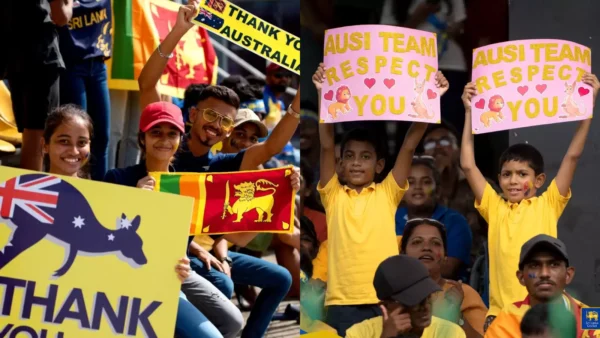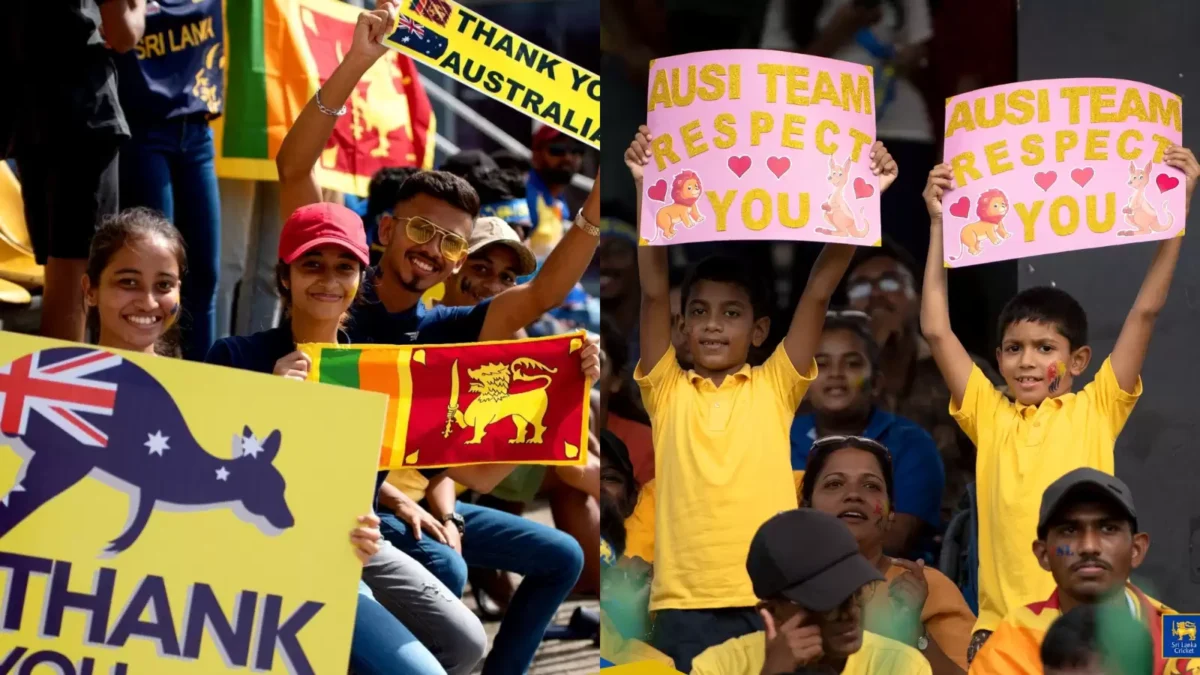
Sri Lanka’s gratitude towards the touring Australia team throughout the ongoing tour, none as vibrant and soothing in the same brief in Colombo on Friday, was a subject of great reverence for the game and beyond.

“The Sri Lanka people are wonderful.”
Aaron Finch’s sentiments in the post-match presser on Friday were ones that transcend sport. On a day he registered a second straight duck, before Alex Carey would guide his side to a tense consolation win, Finch, along with his teammates, would revel in the warm reception from the Colombo crowd largely dressed in yellow, as the tourists thanked the hosts with a lap of honour.
“We’re very grateful that we’ve been able to tour here,” the Australia skipper would go on. “We know the difficulties that Sri Lanka has faced in recent times. Hopefully over these eight white-ball games we’ve been able to provide some joy to people in the country.”
The support was much more substantial to what Rohit Sharma’s India had received during the Nidahas Trophy final four years ago, for that was a product of requital after Sri Lanka’s defeat to Bangladesh earlier.
The Australia appreciation stood for gratitude, as their visit came at a time when the island nation is facing its worst economic crisis since its independence in 1948. The Sri Lankan public has been subject to power cuts, shortages of money, fuel and the rest, while also finding themselves in the midst of violent protests.
As much as sport offers the general life lessons of ups and downs with its immersively varied breadth and depth, it acts as a pleasant distraction and perhaps a stress-buster during challenging times.
Thankfully, the Sri Lankan public have cricket, and merely its sight from a distance has worked just fine.
The nation loves its cricketing heroes regardless of their nationality. As Pathum Nissanka and Kusal Mendis would guide the hosts to a successful 292-run chase in the third ODI, a poster of the late Tony Greig in the stands made for a gripping captivation. The affection between the former England captain-turned-much-celebrated-commentator and Sri Lanka is well documented right since the days of their 1996 World Cup glory, and the nicknaming of a hero Romesh Kaluwitharana as “Little Kalu”.
The recent Sri Lanka-Australia sentiments though would be incomplete without revisiting a rivalry backdrop with its historic reference points. The rivalry doesn’t quite surface as consistently as that of the traditional England-Australia or the ever-tense India-Pakistan, but has had its flashes of history.
Sri Lanka, facing turmoil in the mid-Nineties with security concerns in the midst of a civil war, were blessed with the honour of co-hosting the 1996 World Cup alongside India and Pakistan. However, Mark Taylor’s Australia and Richie Richardson’s West Indies had refused to travel to the country after the Colombo Central Bank blast which happened two weeks before the competition’s start.
Arjuna Ranatunga’s fearless leadership helped Sri Lanka lift their maiden @cricketworldcup trophy in 1996 🏆
On his birthday, watch the story of that historic victory 📹 pic.twitter.com/0xQLtrE5Ax
— ICC (@ICC) December 1, 2020
Skipper Arjuna Ranatunga had famously wished to face Australia in the tournament final, and as it turned out, he’d hit the winning runs to seal the World Cup win against the same opponents in the title clash in Lahore. The no-balling of Muttiah Muralitharan by Darrell Hair at the MCG earlier in the season, and four years later by Ross Emerson at the Adelaide Oval would however add to a sense of victimisation.
Come June 2022, the Sri Lankan spectators dressed in yellow in praise of the Australia side that has toured the country for a multi-format series in desperate times, with cricket offering a sense of temporary relief and perhaps even positivity to the public in the stands and the ones watching on their screens.
The hosts have had the joy on the result front too – sealing the ODI series 3-2 – their first bilateral triumph against Australia since 2010, and the first at home in a staggering three decades.
Skipper Dasun Shanaka, who pulled an incredible heist in the third T20I, securing a win with a ball to spare after 59 were required off 18, might’ve just presented signs of the start of a refreshingly glorious chapter in Sri Lanka’s white-ball history – long missing since the days of Sangakkaras, Jayawardenes, Dilshans and Malingas, with the former speedster watching it all from the sidelines and motivating his young guns in the capacity of a bowling strategy coach.
I’m very happy to see these smiling faces of my people 😇🇱🇰 pic.twitter.com/H4yQDmLpjj
— Dasun Shanaka (@dasunshanaka1) June 11, 2022
Australia, despite all their courteousness, wouldn’t expect much in return on the cricketing front, for they would be presented with rank-turners in the two-match Test series in Galle. The current table-toppers at the World Test Championship 2023 cycle would embrace the challenge, viewing it as a reality check ahead of their India tour later this year.
Fittingly, the tour is set to end with a series contested for a trophy named in honour of Shane Warne and Muttiah Muralitharan, two of the best to have graced the game. Interestingly, in its first edition – Down Under in 2007/08 – Australia had managed to restrict Murali from surpassing Warne’s tally of 708 Test wickets, collecting 400 runs off the off-spinner while giving just four wickets away in two games.
Muralitharan would eventually surpass at his home ground in Kandy against England two weeks later, and the two greats continued to hold each other in high regard. Warne believed that the 800 Test wickets record would never be broken, while Muralitharan asserted that the champion leg-spinner would’ve got many more wickets, following his unfortunate demise in March.
The mutual sense of admiration has now broadened further to rub onto the two teams – one seeking to reinstate their status as world-beaters after the T20 World Cup triumph last year, the other aiming to provide pleasant distraction and relief to its public that seeks joy in defiance to adversity.